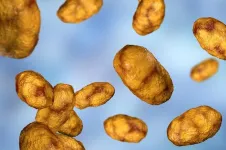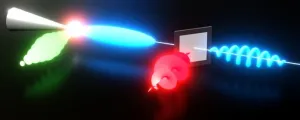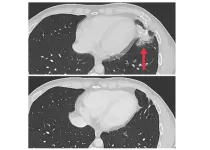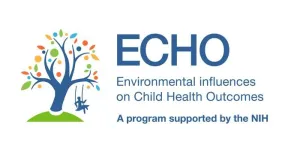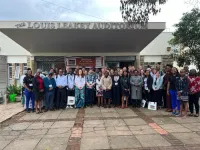(Press-News.org) The fungal pathogen that causes white-nose syndrome (WNS) in bats uses different cell entry strategies depending on the host’s hibernation status – cold and inactive, or warm and active. The findings, which required the authors to develop a new bat cell line, highlight potential therapeutic interventions against WNS using epidermal growth factor receptor inhibitors, like the Food and Drug Administration-approved drug gefitinib. Bats – the second-most diverse group of mammals – play an important part in mitigating agricultural pests and the spread of insect-borne disease. However, millions of hibernating bats across North America are dying from white-nose syndrome – a fatal emerging disease caused by the cold-loving fungus, Pseudogymnoascus destructans. WNS is thought to be responsible for a more than 95% decline in some species and the extirpation of entire populations in some regions. Although WNS was discovered decades ago, there is no practical way to stop the spread of the disease among susceptible bat species, highlighting an urgent need for treatment and prevention strategies. A lack of understanding about how P. destructans invades host tissue, particularly when bats hibernate, has hindered the development of WNS interventions. To address these unknowns, Marcos Isidoro-Ayaza and Bruce Klein developed a novel immortalized keratinocyte cell line from the little brown bat (Myotis lucifugus) and studied P. destructans invasion, in vivo, at different temperatures – to mimic hibernation and arousal. Isidoro-Ayaza and Klein discovered that the fungus uses different strategies to invade bat epidermis cells depending on whether the bats are in their cold, inactive hibernation state or their warmer, active arousal state. During hibernation, when endocytic uptake is idle in the host, fungal hyphae emerging from germinating spores actively tunnel through keratinocytes. Unexpectedly, the burrowing hyphae do not provoke immune defenses in the host cells. Conversely, when temperatures are warmer and the bats are active, the fungus is internalized by keratinocytes via endocytosis. According to the findings, both infection routes require the epidermal growth factor receptor (EGFR), and the authors show that blockade of EGFR using the small-molecule drug gefitinib and anti-EGFR antibodies prevented P. destructans entry into host keratinocytes. “Host invasion is one of the first steps in disease establishment and critical to disease progression,” writes José Vargas-Muñiz in a related Perspective. “Therefore, this process is a prime candidate for mitigating [P. destructans] infection in hibernating bats.”
END
Warm or cold: Hibernation status matters when white-nose syndrome pathogen infects bats
2024-07-11
ELSE PRESS RELEASES FROM THIS DATE:
Barley’s rapid climate-driven adaption revealed in century-old biological experiment
2024-07-11
Leveraging one of the world’s oldest biological experiments – which began in 1929 – researchers have uncovered how a major crop, barley, was shaped by both agricultural pressures and its changing natural environment. The results underscore the power of long-term studies in understanding the dynamics of adaptive evolution. The survival of cultivated plants after their dispersal across different environments is a classic example of rapid adaptive evolution. For example, barley, an important neolithic crop, spread widely after domestication over 10,000 years ago to become a staple source of nutrition for humans and livestock throughout Europe, Asia, and Northern ...
Stratospheric air intrusions drive new particle formation in the upper troposphere
2024-07-11
New atmospheric particles form when stratospheric air intrudes into the troposphere below, according to a new study, revealing a previously unrecognized mechanism for new particle formation (NPF) in the upper troposphere. The finding suggests that NPF in these regions aloft occurs frequently and over large geographic regions, representing an important source of particles in the free troposphere. Aerosol particles smaller than one micron in diameter are abundant in the troposphere, the lowest layer of ...
Respiratory bacteria ‘turns off’ immune system to survive
2024-07-11
Researchers from The University of Queensland have identified how a common bacterium is able to manipulate the human immune system during respiratory infections and cause persistent illness.
The research, led by Professor Ulrike Kappler from UQ’s School of Chemical and Molecular Biosciences, studied the virulence mechanisms of Haemophilus influenzae, a bacterium that plays a significant role in worsening respiratory tract infections.
“These bacteria are especially damaging to vulnerable groups, such as those with cystic fibrosis, asthma, the elderly, ...
Structured electrons with chiral mass and charge
2024-07-11
Have you ever placed the palm of your left hand on the back of your right hand, in such a way that all fingers point in the same direction? If you have, then you probably know that your left thumb will not touch its right counterpart. Neither rotations nor translations nor their combinations can turn a left hand into a right hand and vice versa. This feature is called chirality.
Scientists at the University of Konstanz have now succeeded to imprint such a three-dimensional chirality onto the wave function of a single electron. They used laser light to shape the electron’s matter wave into left-handed or right-handed coils ...
Learning dance moves could help humanoid robots work better with humans
2024-07-11
Engineers at the University of California San Diego have trained a humanoid robot to effortlessly learn and perform a variety of expressive movements, including simple dance routines and gestures like waving, high-fiving and hugging, all while maintaining a steady gait on diverse terrains.
The enhanced expressiveness and agility of this humanoid robot pave the way for improving human-robot interactions in settings such as factory assembly lines, hospitals and homes, where robots could safely operate alongside humans or even replace them in hazardous environments like laboratories or disaster sites.
“Through expressive and more human-like ...
Women and social exclusion: The complicated nature of rejection and retaliation
2024-07-11
New research from the University of Ottawa (uOttawa) has provided a complicated glance into young women’s responses to interpersonal conflict, with retaliation often the answer to rejection and perceived social exclusion by other females.
The study, published in Nature’s Scientific Reports, highlights the complicated nature of women’s interpersonal relationships by examining the stress arising from rejection, and if the personal characteristics of those imposing the rejection influences ...
Immunotherapy approach shows potential in some people with metastatic solid tumors
2024-07-11
Early findings from a small clinical trial provide evidence that a new cellular immunotherapy approach may be effective in treating metastatic solid tumors. In the trial, researchers from the National Institutes of Health (NIH) genetically engineered normal white blood cells, known as lymphocytes, from each patient to produce receptors that recognize and attack their specific cancer cells. These initial findings are from people with metastatic colorectal cancer who had already undergone multiple earlier treatments. The personalized immunotherapy shrank tumors in several patients and was able to keep the tumors from regrowing for up to seven months. ...
Neighborhood impact on children's well-being shifted during COVID-19 pandemic, ECHO study suggests
2024-07-11
The COVID-19 pandemic significantly disrupted daily life and has raised concerns about its impact on children’s well-being. A new study from the NIH Environmental influences on Child Health Outcomes Program (ECHO) sheds light on how a neighborhood’s physical and social environment influenced a child’s well-being before and during the pandemic.
According to an analysis of ECHO Cohort data, the neighborhood environment was less likely to be associated with child well-being during the ...
Neurobiologist Sung Soo Kim receives 2024 Scholar Award from McKnight Foundation
2024-07-11
(Santa Barbara, Calif.) — Birds migrating. Your cat, returning home from a day of roaming. Bees taking pollen to their hives. You, finding yourself back home without actually remembering the drive from work. Animal navigation is a fundamental behavior, so innate that most of the time we don’t notice that we’re doing it. And yet, so many times a day we (and the animals around us) unerringly find our ways to our target locations whether they be old haunts or new venues, from different directions and even in the dark.
How do we do it? That’s the question UC Santa Barbara neurobiologist Sung Soo Kim seeks to ...
Charting an equitable future for DNA and ancient DNA research in Africa
2024-07-11
CLEVELAND AND NAIROBI — July 11, 2024 — Today, the American Journal of Human Genetics published a perspective piece on the need for an equitable and inclusive future for DNA and ancient DNA (aDNA) research in Africa. The paper, coauthored by an international team of 36 scientists from Africa, North America, Asia, Australia, and Europe, was led by Dr. Elizabeth (Ebeth) Sawchuk of the Cleveland Museum of Natural History and Dr. Kendra Sirak of Harvard University.
DNA from ancient and living African peoples is critical for researchers studying our species’ evolution and population ...
